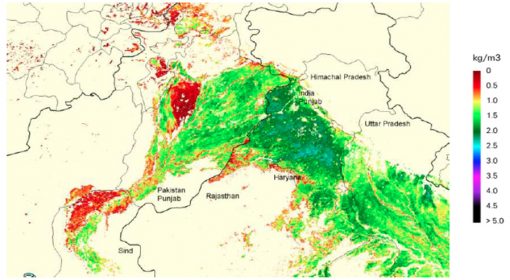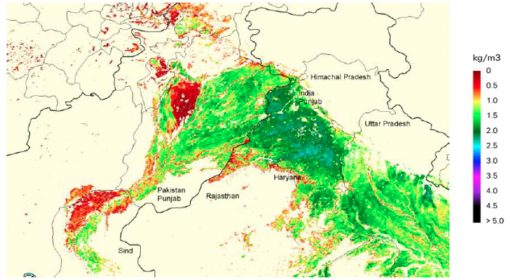Posted by Frank van Steenbergen and Alan Macdonald
November 19, 2013

It must be the world’s greatest single groundwater system, at least in terms of the population it supports. It is the mirror image of the Himalayas – the huge Indo-Gangetic Plains. The groundwater system stretches in a wide arc from Bangladesh to Pakistan, covering in between a large part of northern India as well as the southern part of Nepal.
In the image above a preliminary snapshot of the Indo-Gangetic aquifer system is given, courtesy of an ongoing Research into Policy Project of the British Geological Survey and partners, that is aiming to better understand the entire regional groundwater system and the resilience to climate change.
Aquifers in the Indo-Gangetic Plains are often thick – sometimes more than two kilometres – like an inverted mountain range. They have been formed by millennia of gravel, sand and clay being deposited by the Ganges and Indus. The water resources are abundant and recharged by two of the world’s mightiest rivers. Most of this immense area has groundwater available at a very shallow depth that is easy to reach – sustaining cities, villages and intense agriculture. All in all, a billion people live on and from this groundwater system.
It is not that the system is free of problems and challenges. The deeper groundwater is often saline. In Bangladesh and West Bengal (India) much of the shallow groundwater contains arsenic. This has caused arsenicosis – appearing, among others, in the form of cancer of the skin. In Uttar Pradesh in eastern India, agriculture is intense but would benefit from more systematic joint use of groundwater and river water to help prevent flooding. In the western part of the basin in the Indian Punjab groundwater use is very intensive, supporting triple cropping. At the same time, groundwater levels in this grain basket have declined steeply – dropping from 10 meters twenty years ago to more than thirty meters now. In various parts of the basin groundwater is contaminated, both by naturally occurring contaminants and by human activity.
In the Pakistani Punjab, the intense use of groundwater has been a boon. It has allowed much higher cropping intensities especially in areas with fresh groundwater. Heavy pumping by a million farmer wells here has led to water logging, the menace of the past, largely disappearing. Over the past few past decades water tables have been dropping in the Punjab, but only by centimetres every year. However, the southern part of the western IGB (i.e. Sindh Province) is still a big problem with widespread water logging and salinity. In two-fifths of the area the soils are fully saturated, often with saline water. This is related to the unbalanced surface irrigation supplies in Sindh. Water logging causes not only crop losses but also invites all kind of diseases – from malaria to liver fluke for livestock. The high groundwater tables of Sindh amount to a large man-made humanitarian disaster.

What is amazing about the groundwater across the Indo-Gangetic Basin is the lack of governance systems to manage the groundwater. There may be 5 to 10 million pumpsets accessing the resource, but till date there is no arrangement that regulates either use or supply. Even at a more basic level, large parts of the groundwater systems are not measured. In this age of Big Data and Big Brother this is quite amazing. A single system that supports one-seventh of the global population is largely terra incognita.
There are several ways to manage the huge groundwater systems of Indus and Ganges better. Groundwater for drinking purposes can be sourced from the right layers and locations to minimise contamination; surface irrigation can be managed better as this holds the key to preventing water logging and avoiding groundwater decline; peak waters can be used better for recharge to compensate for heavy pumping in the areas concerned; and there is a range of solutions to deal with salinity.
There is a huge need to understand these mega-systems clearly as they hold the key to global-level water and food security. There are these days a large number of people who have a good understanding of the ‘small solutions’ – from rooftop water harvesting to micro-irrigation. At the same time there is a glaring lack of expertise on the ‘Inverted Himalayas,’ the Indo-Gangetic System, the world’s most used groundwater body. This has to change urgently.

{jcomments on}

